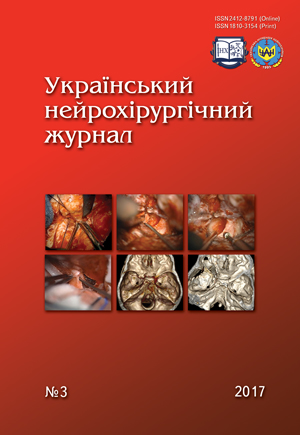Еndoscopic possibilities of the acoustic schwannomas removal in internal auditory canal
DOI:
https://doi.org/10.25305/unj.112104Keywords:
schwannomas, schwannomas spread into internal auditory canal, endoscopic removal of schwannomasAbstract
Aim. To investigate the features of schwannoma spread into internal auditory canal and methods for its removal.
Materials and methods. The paper analyzes the results of surgical treatment of 18 patients with schwannomas spread into internal auditory canal. Tumor microsurgical removal was carried out in 12 cases (in 7 cases using endoscopic assistance technique). Fully endoscopic excision of vestibular schwannomas was performed in 6 cases.
Results. Gross total resection was achieved in 16 cases, subtotal resection in 2 cases. Using endoscopic assistance technique during the removal of the intracanal part of the schwannoma provides best visualization along the channel axis. The facial nerve was anatomically preserved in 17 patients (94%), the facial nerve function was preserved in 16 patients (88%), hearing was preserved in 3 patients (16%).
Conclusions. 1) Endoscopic revision of the tumor spread into internal auditory canal is relevant and rational when using microsurgical opening of internal auditory canal; 2) trepanation of internal auditory canal using full endoscopic method (or endoscopic assistance technique) forms a larger trepanation window in internal auditory canal compared to microsurgical method; 3) endoscopic technique provides better visualization of internal auditory canal along its length; 4) Keyhole surgery and endoscopic technique of tumors of the cerebellopontine angle are recommended for small schwannomas (up to24 mm).
References
1. Roosli C, Linthicum FH Jr, Cureoglu S, Merchant SN. What is the site of origin of cochleovestibular schwannomas? Audiol Neurootol. 2012;17(2):121-5. [CrossRef] [PubMed] [PubMed Central]
2. Paldor I, Chen AS, Kaye AH. Growth rate of vestibular schwannoma. J Clin Neurosci. 2016 Oct;32:1-8. [CrossRef] [PubMed]
3. Sayegh ET, Kaur G, Ivan ME, Bloch O, Cheung SW, Parsa AT. Facial neuroma masquerading as acoustic neuroma. J Clin Neurosci. 2014 Oct;21(10):1817-8. [CrossRef] [PubMed]
4. Salzman KL, Childs AM, Davidson HC, Kennedy RJ, Shelton C, Harnsberger HR. Intralabyrinthine schwannomas: imaging diagnosis and classification. AJNR Am J Neuroradiol. 2012 Jan;33(1):104-9. [CrossRef] [PubMed]
5. Presutti L, Magnaguagno F, Pavesi G, Cunsolo E, Pinna G, Alicandri-Ciufelli M, Marchioni D, Prontera A, Gioacchini FM. Combined endoscopic-microscopic approach for vestibular schwannoma removal: outcomes in a cohort of 81 patients. Acta Otorhinolaryngol Ital. 2014 Dec;34(6):427-33. [PubMed] PubMedCentral PMCID: PMC4346999/">[PubMed Central]
6. Roosli C, Linthicum FH Jr, Cureoglu S, Merchant SN. What is the site of origin of cochleovestibular schwannomas? Audiol Neurootol. 2012;17(2):121-5. [CrossRef] [PubMed] [PubMed Central]
7. Wiegand DA, Ojemann RG, Fickel V. Surgical treatment of acoustic neuroma (vestibular schwannoma) in theUnited States: report from the Acoustic Neuroma Registry. Laryngoscope. 1996 Jan;106(1 Pt1):58-66. [CrossRef] [PubMed]
8. Ahmad RA, Sivalingam S, Topsakal V, Russo A, Taibah A, Sanna M. Rate of recurrent vestibular schwannoma after total removal via different surgical approaches. Ann Otol Rhinol Laryngol. 2012 Mar;121(3):156-61. [CrossRef] [PubMed]
9. Van Abel KM, Carlson ML, Link MJ, Neff BA, Beatty CW, Lohse CM, Eckel LJ, Lane JI, Driscoll CL. Primary inner ear schwannomas: a case series and systematic review of the literature. Laryngoscope. 2013 Aug;123(8):1957-66. [CrossRef] [PubMed]
10. Ansari SF, Terry C, Cohen-Gadol AA. Surgery for vestibular schwannomas: a systematic review of complications by approach. Neurosurg Focus. 2012 Sep;33(3):E14. [CrossRef] [PubMed]
11. Kumon Y, Kohno S, Ohue S, Watanabe H, Inoue A, Iwata S, Ohnishi T. Usefulness of endoscope-assisted microsurgery for removal of vestibular schwannomas. J Neurol Surg B Skull Base. 2012 Feb;73(1):42-7. [CrossRef] [PubMed] [PubMed Central]
12. Hori T, Okada Y, Maruyama T, Chernov M, Attia W. Endoscope-controlled removal of intrameatal vestibular schwannomas. Minim Invasive Neurosurg. 2006 Feb;49(1):25-9. [CrossRef] [PubMed]
13. Shahinian HK, Ra Y. 527 fully endoscopic resections of vestibular schwannomas. Minim Invasive Neurosurg. 2011 Apr;54(2):61-7. [CrossRef] [PubMed]
Downloads
Published
How to Cite
Issue
Section
License
Copyright (c) 2017 Orest I. Palamar, Andriy P. Huk, Dmytro I. Okonskyi, Ruslan V. Aksyonov, Dmytro S. Teslenko

This work is licensed under a Creative Commons Attribution 4.0 International License.
Ukrainian Neurosurgical Journal abides by the CREATIVE COMMONS copyright rights and permissions for open access journals.
Authors, who are published in this Journal, agree to the following conditions:
1. The authors reserve the right to authorship of the work and pass the first publication right of this work to the Journal under the terms of Creative Commons Attribution License, which allows others to freely distribute the published research with the obligatory reference to the authors of the original work and the first publication of the work in this Journal.
2. The authors have the right to conclude separate supplement agreements that relate to non-exclusive work distribution in the form of which it has been published by the Journal (for example, to upload the work to the online storage of the Journal or publish it as part of a monograph), provided that the reference to the first publication of the work in this Journal is included.









